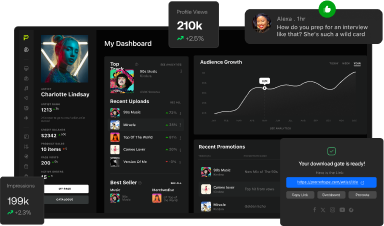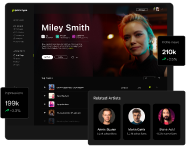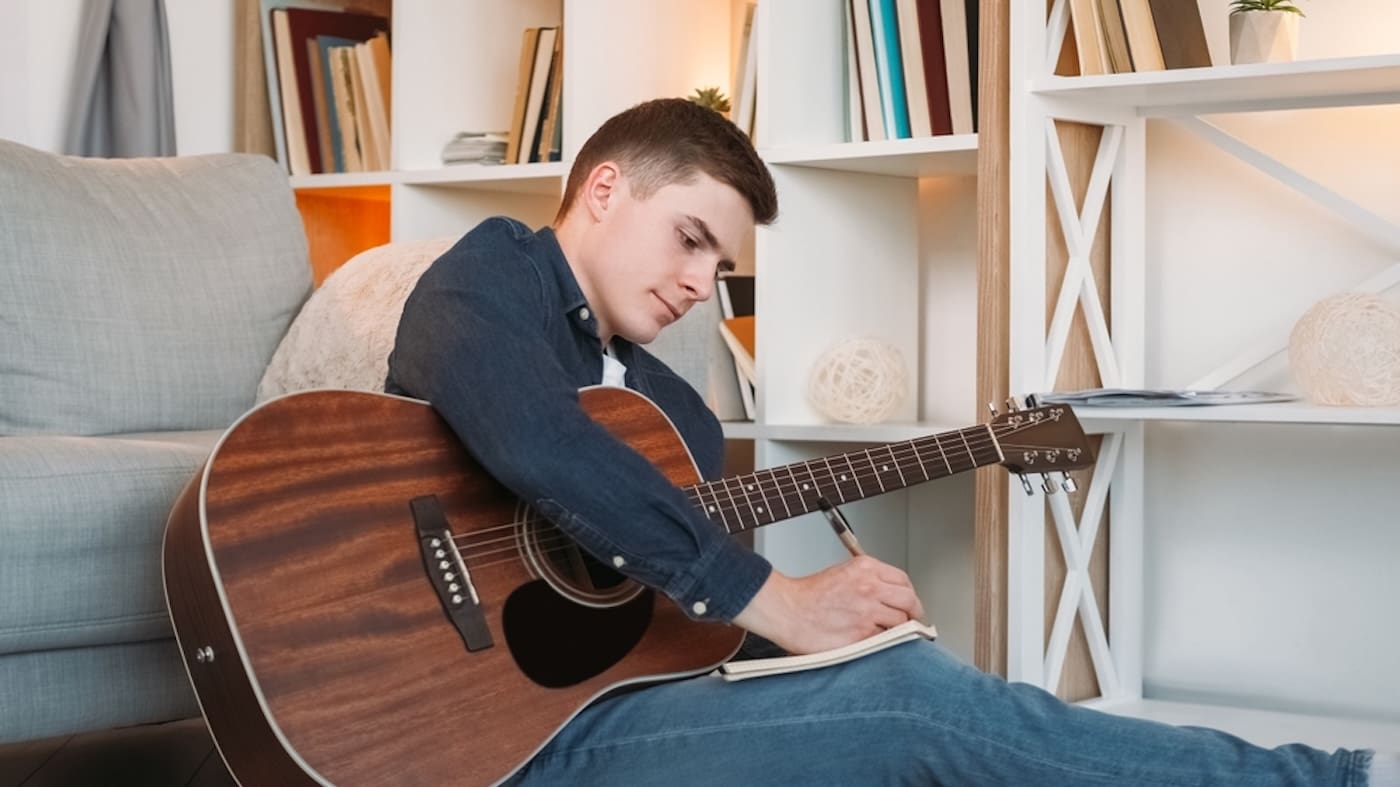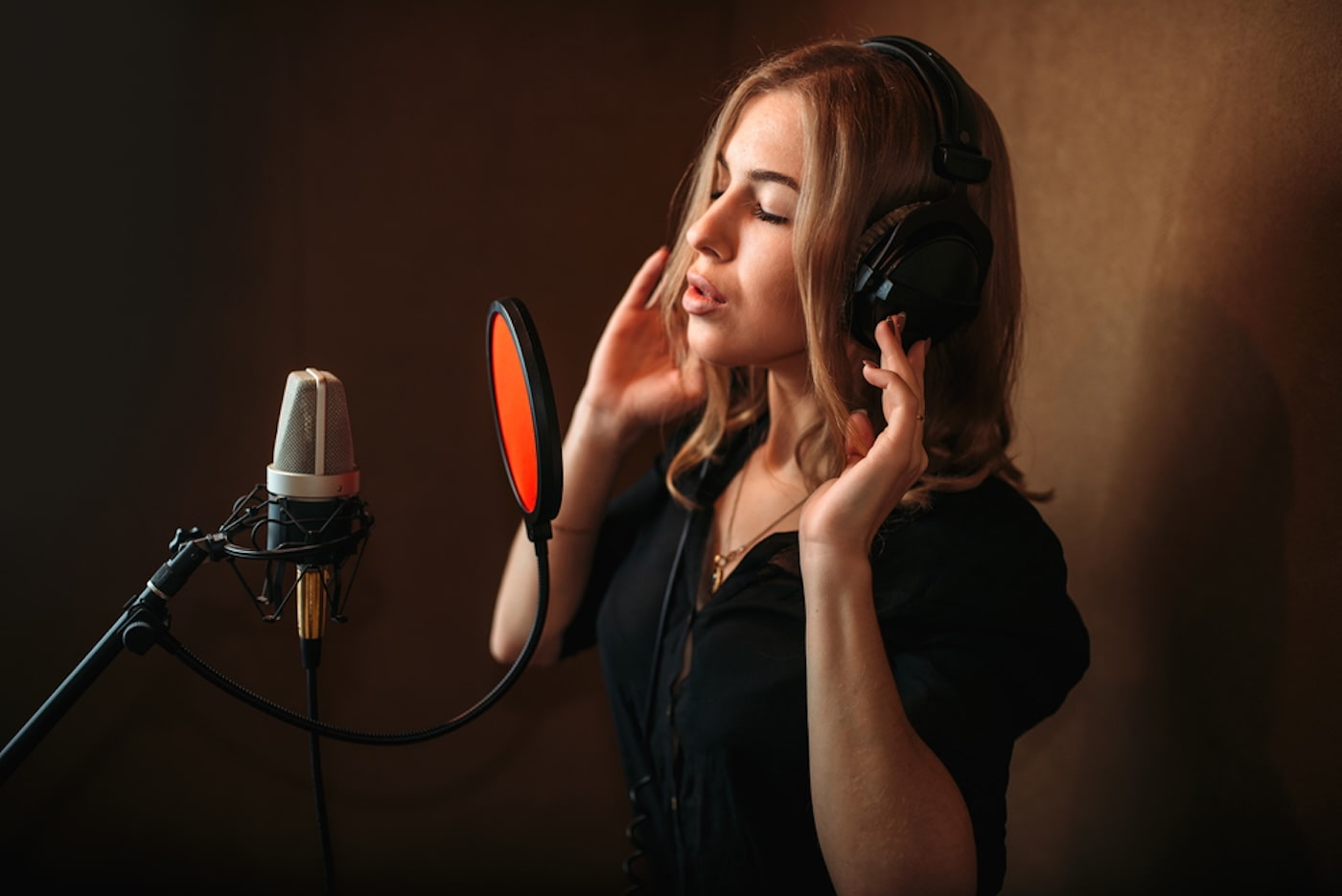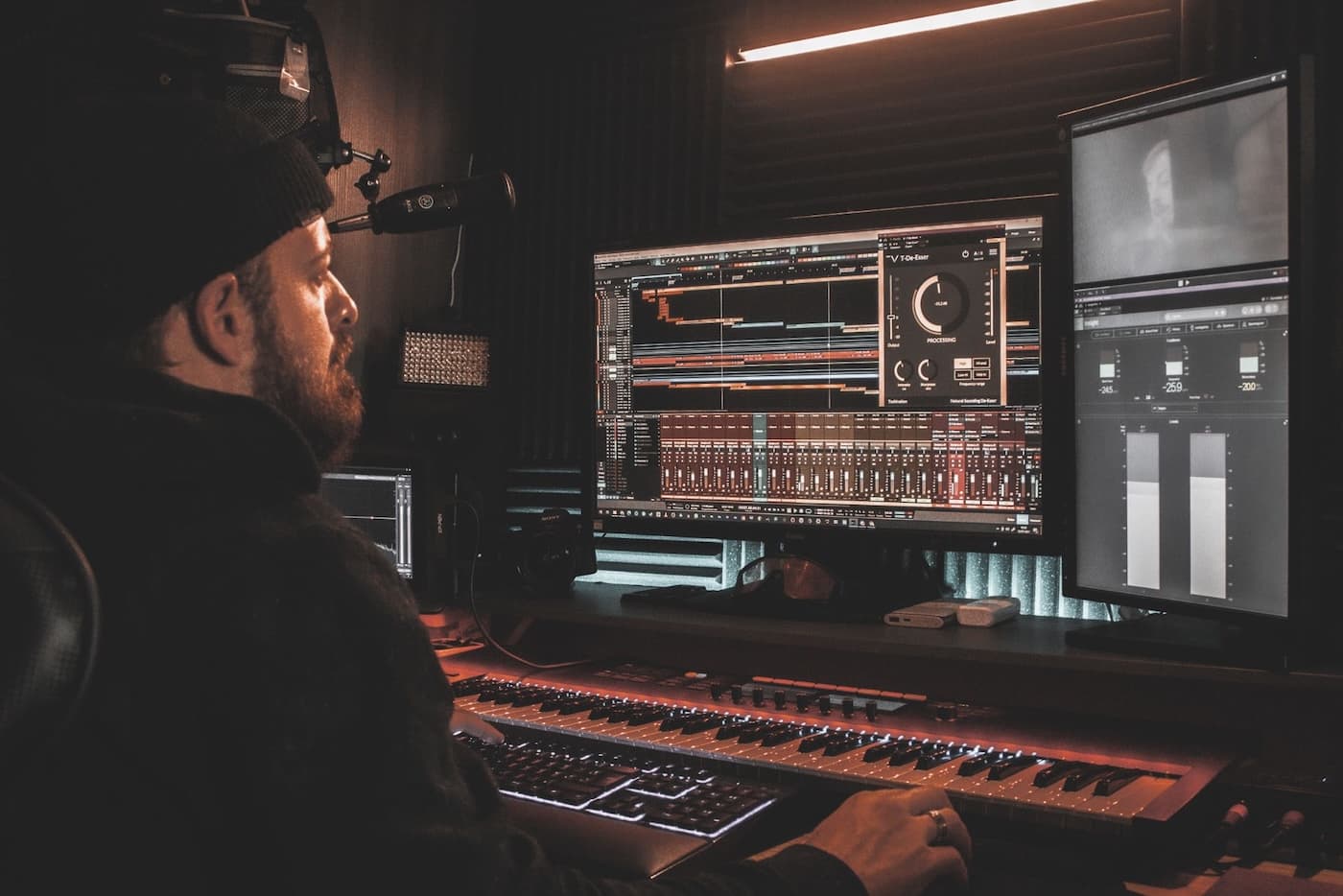
Venturing into music production involves setting up the necessary equipment required for your chosen style and genre.
The best music production equipment for beginners allows for complete track creation on a budget, from sequencing to mastering.
This guide explores everything beginners need to produce music, from essential software to studio monitors and acoustic instruments.
Get Early Access
To Promo Hype
The Best Music Production Equipment For Beginners In 2025
Whether producing electronic music or collaborating with singer-songwriters, high-quality production equipment is essential.
Here’s everything you need to become a music producer and start creating music with a professional sound.
1. Computer Or Laptop
Price range: $300 – $500
Recommendations for beginners: Acer Aspire 5 A515, MacBook Air M4
One of the most essential items of equipment required to make music is a computer or laptop, which serves as the central hub.
The computer powers your chosen digital audio workstation and other software used for editing, recording, and exporting audio files.
As such, the requirements will vary depending on the software being used and the minimum specifications required for it to function.
If your existing computer lacks the necessary performance capabilities to run a DAW smoothly, you can upgrade components accordingly.
There are other methods you can adopt to improve your computer’s power and enhance the performance of a DAW.
Some of these methods include:
- Upgrading to an SSD: SSD cards are now the standard in new computers, but if you’re working on an older PC, you should consider upgrading your hard drive to this format.
- Adding more RAM: A lack of RAM is a common performance obstacle, so increasing this to a minimum of 16GB is essential if your PC is lacking in this area.
- Investing in an external sound card: If you’re using the basic sound card included with your PC, you can achieve much more production-wise by upgrading this to an external version.
While some of the best music producers create music with unconventional hardware, the computer remains a crucial component of their workflow.
The flexibility of PCs also aids in budget management, allowing beginners to upgrade components over time.
As new hardware, such as drum machines and synthesizers, is added, producers can upgrade their audio interface to accommodate it.
This ability to iterate and improve the home studio applies to all other required equipment for a fully personalized setup.
Learn more about music production in the Promo Hype Community.
2. Digital Audio Workstation (DAW)
Price range: Free – $9.99/month
Recommendations for beginners: FL Studio, GarageBand
The next critical element of a music production studio is music production software, which producers typically use in conjunction with a digital audio workstation (DAW).
Your choice of digital audio workstation will depend on various factors, including your computer model and available budget.
The best DAWs deliver the complete music production pipeline, from recording and editing to mixing, mastering, and exporting files.
Covering the entire creative process, DAWs can interface with physical hardware, whether using a MIDI keyboard or recording vocals.
There are many options for new producers looking for a DAW, from free-to-use or budget-friendly programs to professional production suites.
Here’s an overview of some of the most popular DAWs and how to determine which one to use when making music:
Logic Pro X
If you’re creating music on a Mac OS system, Logic Pro X is the obvious choice for your digital audio workstation.
This hugely popular DAW is packed with tools for editing and mixing sounds, with a broad application across all genres.
It also features a streamlined and intuitive workflow and interface that’s not too challenging for beginners to learn.
Ableton Live
Dance music production is well-served by Ableton Live DAW, with its focus on beat creation and a wealth of instruments and plugins.
Ableton Live’s performance capabilities also open up its application as a powerful tool for producers gigging at venues,
The developers deliver frequent upgrades, such as the ability to integrate external synthesizers, which opens up a range of creative options.
FL Studio
Formerly known as FruityLoops, FL Studio is another dance music-friendly DAW with a fun and engaging user interface and range of tools.
A more affordable option, it’s nevertheless a powerful option with plenty of longevity and the ability to integrate hundreds of plugins.
Pro Tools
The go-to DAW for professional recording studios and music production schools, Pro Tools has long been the industry standard.
Pro Tools is traditionally associated with band music production, but its comprehensive editing features are robust across all genres.
It’s one of the more expensive DAWs, but a sound investment for anyone dedicated to producing music using traditional instruments.
GarageBand
A free-to-use DAW with a band-first approach to production is GarageBand, developed by Apple for Mac and iOS devices.
Its launch was a game-changer for independent artists, and GarageBand changed music production on portable devices.
Producers can perform all aspects of production with GarageBand, recording, editing, and looping instruments, and adding desired effects.
3. Audio Interface
Price range: $50 – $150
Recommendations for beginners: Focusrite Scarlett Solo, Native Instruments Komplete Audio 2
Another essential piece of equipment that producers require is an audio interface, which bridges the gap between analog and digital audio.
Suitable for all popular music genres, the audio interface enables you to connect and record instruments such as guitars and drums.
They’re also capable of connecting multiple microphones for recording entire bands, but the price increases accordingly.
Connections featured on an audio interface include 1/4 inch jacks for guitars and XLR connections for one or more microphones.
As such, your audio interface budget will be influenced by the number of inputs required for your creative workflow.
4. MIDI Controller/Keyboard
Price range: $50 – $200
Recommendations for beginners: Akai MPK Mini Mk3
Most newcomers to music production with limited hands-on experience are likely familiar with the piano roll featured in DAWs.
This visual representation of a piano allows producers to tap in notes on a grid to form melodies and chords with MIDI instruments.
While this process is satisfactory for creating music on a laptop, it can become time-consuming and inefficient over time.
That’s where the MIDI device comes into play, streamlining compositions through the use of a MIDI keyboard that eliminates the need for a piano roll.
Using a MIDI keyboard not only provides physical keys for composing melodies and playing chords, but also performance pads for percussion.
The result transforms the process of music production into a tactile, responsive experience, allowing for nuanced and experimental performances.
Other MIDI controller types that can be used for music production alongside a MIDI keyboard include drum pads and faders.
If you’re already proficient at playing the guitar or wind instruments, a MIDI controller of this type is an option worth considering.
5. Monitor Speakers & Headphones
Price range: Monitor speakers, $100-$500. Headphones. $40 – $120
Recommendations for beginners: Adam Audio T5V speakers, Sony MDR 7506 headphones
It should go without saying that producing music requires the best possible audio output to ensure the music sounds great.
This means investing in monitor speakers and headphones that deliver a balanced and accurate response to your music.
You don’t have to invest in high-end gear used at the best music production schools; budget-friendly speakers and headphones are available.
Likewise, if you’re focusing on laptop-based music production, you can forgo monitor speakers and allocate your budget to headphones instead.
When assessing monitor speakers for your studio, consider whether you need active or passive speakers, as the latter require separate amplifiers.
The two main types of headphones are closed and open-back, with the former offering impressive isolation and the latter a wider soundstage.
Get Early Access
To Promo Hype
6. Microphone
Price range: $60 – $120
Recommendations for beginners: Shure SM57, Audio Technica ATR2500x-USB
Another essential part of a home studio setup is a microphone, which is used for recording vocals and samples to use in your music.
You don’t have to spend a fortune on your first microphone; several quality options are available that deliver fantastic results on a budget.
However, upgrading to more expensive equipment will make a significant difference when recording vocals, real instruments, and other sounds.
There are two core types of microphones to consider investing in, which are fundamental aspects of what music producers do.
Let’s break down the difference between dynamic microphones and condenser microphones in more detail:
- Dynamic microphones: These types of microphones are often used for live performances, but have a place in the studio for recording instruments such as drums and amplified guitars.
- Condenser microphones: A more suitable format for new producers, condenser microphones are designed for vocal performance and other instrument recordings in a controlled setting.
As your studio expands, you can add new microphones to allow for multi-instrument and vocal recording sessions.
7. Audio Plugins & Sound Libraries
Price range: Free – $120
Recommendations for beginners: Waves’ Essentials Bundle/Loopcloud
Another core aspect of using a DAW for music production is the application of audio plugins and VST instruments on projects.
These are combined with sound libraries to create all aspects of a track, from percussion and effects to vocals and synthesizers.
Sound libraries can be purchased as sample packs, which are available for all genres and include a variety of samples to use.
These include individual percussion hits and drum loops, vocal accapelas, synth arrangements, and other elements.
Audio plugins can then be used to apply various effects to samples or MIDI instruments as part of the editing process.
Producers can purchase high-quality VST instruments and plugins that emulate classic hardware used in studio recordings.
For example, if you want your music to sound like it’s running through acoustic guitar amps, there are plugins that do the job.
You don’t have to spend money on plugins, and the best free VST plugins deliver exceptional performance when used correctly.
Here are some of the commonly adopted plugins used for music production:
- Effects plugins: Effects plugins are essential for reshaping the sound of an audio file, whether manipulating frequencies or creating echoes and distortions. Most DAWs feature a range of effects plugins as standard, including reverb, delay, echo, chorus, and flanger.
- Mixing and mastering plugins: Making music sound polished requires mixing and mastering, using EQs and other tools to balance frequency ranges and volume levels. Additional mixing and mastering plugins for audio compression and limiting can further add to your production value.
- VST instruments: If you’re looking for emulations of classic synthesizers or drum machines, VST instruments are available to recreate their unique sounds. You can use your MIDI keyboard to perform your compositions, mapping parameters to your controller’s knobs and sliders.
There are numerous resources available for beginners to discover music production tips that help them utilize these plugins to their full potential.
As your production techniques evolve, you can introduce new plugins and VST instruments that complement your processes.
Enjoy global music distribution with Promo Hype.
8. Traditional Instruments
Price range: $50 – $250
Recommendations for beginners: Piano
Your chosen music genre and abilities heavily influence the role of traditional instruments in music production.
If you’re venturing into production for bands or singers, you’ll likely have an acoustic guitar and drums in your repertoire.
While such instruments are essential for rock and other similar genres, they can still have a place in setups for different music styles.
Many who produce in electronic music genres invest in percussive instruments they can perform and sample for their tracks.
Other popular instruments can also bring a more organic texture to dance music production, elevating production values.
They’re by no means essential for beginner music production equipment setups, but can play a significant role in specific workflows.
9. Cables & Accessories
Price range: $50 – $100
Recommendations for beginners: Neutrik XLR Connectors
Each music production setup requires the necessary cables and accessories to connect everything into a cohesive ecosystem.
Here’s an overview of some of the standard cable types and how they are used to connect music production equipment:
- XLR cable: This is primarily used for microphones, offering noise reduction and interference reduction.
- TRS cable (1/4″): Similar to a headphone jack, this is used for connecting monitors, mixers, and audio interfaces.
- MIDI cable: While many new MIDI controller devices use USB, older MIDI-based hardware typically employs the standard MIDI cable.
- USB cable: Most modern hardware utilizes the USB format, including USB-C and USB Micro.
Investing in spare cables and accessories, such as microphone stands, will ensure your setup is easy to use.
10. Workspace & Acoustic Treatment
Price range: Free/DIY – $500
Recommendations for beginners: AcouFoam Acoustic Panels
If you’re starting out producing music on a DAW, you won’t need to upgrade your workspace to accommodate new equipment.
Once you start introducing MIDI keyboards and other instruments, however, the limitations of your desk will soon be apparent.
Fortunately, office furniture can be purchased cheaply, and if you have more cash to spare, you can pick up dedicated desks for music production.
Likewise, acoustic treatment is an optional extra that can be added for a very low cost using a do-it-yourself approach.
There are also affordable acoustic treatment panels that you can add discreetly to problem zones without having to treat an entire room.
Related reading: Learn how to write a song.
Music Production Equipment Tips
Investing in the best equipment lays the foundation for producing music, but it can also feel daunting for beginners.
Fortunately, there are methods you can adopt that make it easy to master the fundamental processes and maximize the benefits of your gear.
Here are some music production equipment tips to help you get started smoothly:
- Check out online tutorials: Music production involves many interrelated processes that can become overwhelming for newcomers. If you find yourself getting stuck or want to hone in on a particular technique, check out online tutorials and music production courses.
- Learn basic music theory: A basic grasp of music theory will go a long way to streamlining compositions and making your music sound impressive. You can begin with basic melodies and harmonies, building up your knowledge of music theory from there.
- Collaborate with other artists: If you have friends who sing or play piano or other instruments, getting them involved is an excellent way to hone your skills. They bring unique experiences to the table and can help you understand concepts quickly.
- Experiment regularly: While referencing user manuals and tutorials provides a shortcut for learning, don’t underestimate the power of experimentation. Many producers have enjoyed happy accidents while playing around with plugins and VST instruments.
With countless tutorials from established producers to explore, mastering the basics of music production equipment has never been easier.
How Much Should Beginners Spend On A Home Studio?
Before building a music production studio, it’s essential to assess various factors to determine an appropriate budget.
Let’s explore some factors to consider that will play a role in the music production equipment you need:
- Chosen style of music: Your preferred genre will play a significant role in the necessary equipment, particularly if you want to produce music for live bands. Research the core gear needed based on your musical preferences before investing any money.
- Current computer setup: Investing in a brand new computer isn’t always necessary when becoming a music producer, as your existing setup may be sufficient. Check your computer’s specifications and compare them with your preferred software to determine if minor upgrades, such as additional RAM or a new sound card, will be sufficient.
- Musical abilities: If you’re experienced playing traditional instruments and want to record them, you need to set up a home recording studio. This will add to the overall budget for condenser microphones and other essential equipment.
- Future-proofing your production equipment: Investing in future-proof equipment may be more expensive upfront, and it may be out of reach for those on a budget. That said, if you have the funds to do so, it can save you hassle in the long term by avoiding piecemeal upgrades.
If your finances are limited, you can still start producing music using a basic setup that doesn’t break the bank.
Here’s an overview of what a basic setup entails, along with average prices to reference:
- Laptop or computer: Producing music on a laptop or computer doesn’t have to break the bank, with entry-level options ranging from $300 to $500.
- Audio interface: Budget-friendly audio interface options for beginner producers can be picked for $50 to $150.
- Production software: DAWs range from completely free options, such as Audacity and GarageBand, to affordable subscription models for Ableton Live and Logic Pro X, which start at $4.99 to $9.99 per month.
- Microphone: A basic, entry-level microphone can be purchased relatively cheaply, with a price range of between $60 and $120.
- Studio headphones: Many sub-$50 headphones are suitable for music production, including those from reputable brands like Sennheiser and Beyerdynamic.
For those with larger budgets, this basic equipment setup can be enhanced with optional extras to improve the overall experience.
Studio monitors can be used as an alternative to headphones, and adding a MIDI controller will further enhance the workflow.
You can upgrade gear to better models and add new hardware as your music production evolves to meet new requirements.
Share Your Music With A Global Audience With Promo Hype
Once you’ve mastered music production and created amazing music, it’s ready to be shared with a large audience.
By becoming a Promo Hype member, you can reach a global fan base and showcase your skills as a music producer.
Here are some of the Promo Hype features used by successful independent artists to build their online presence:
- Instant distribution across all streaming platforms: Music fans use various streaming platforms to access the artists they love. With Promo Hype, new music can be scheduled and released on Spotify, TIDAL, Apple Music, Amazon Music, and other major platforms.
- Robust tools to promote new releases and gigs: Whether you’re promoting a new single or generating buzz for an upcoming gig, Promo Hype can help. By using the Promotional Toolkit, bands and producers can allocate marketing budgets for maximum impact.
- In-depth analytics to understand audience behaviors: Understanding which streaming platforms yield the best engagement is vital for effective planning. Promo Hype’s dashboard features powerful analytical tools that enable you to delve into your performance metrics.
- Community forums to connect with other artists: If you’re eager to collaborate with other musicians or seeking advice, Promo Hype members can connect in the Community. Share music production tips or discuss collaborations with like-minded artists.
With a dedicated support team of music industry experts, Promo Hype covers everything independent artists need to drive their careers.
Summary
Producing music is easier than ever, thanks to budget-friendly hardware and software that deliver high-quality results for newcomers.
Referencing this guide to the best music production equipment for beginners will ensure your setup matches your budget and requirements.
As you gain more experience, you can upgrade your setup and introduce new gear to streamline your music production efforts.
Get Early Access
To Promo Hype
Join Promo Hype
